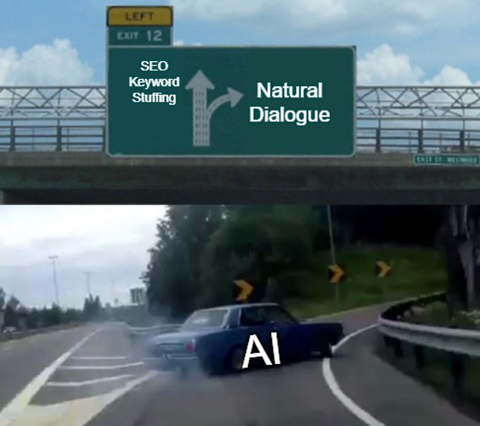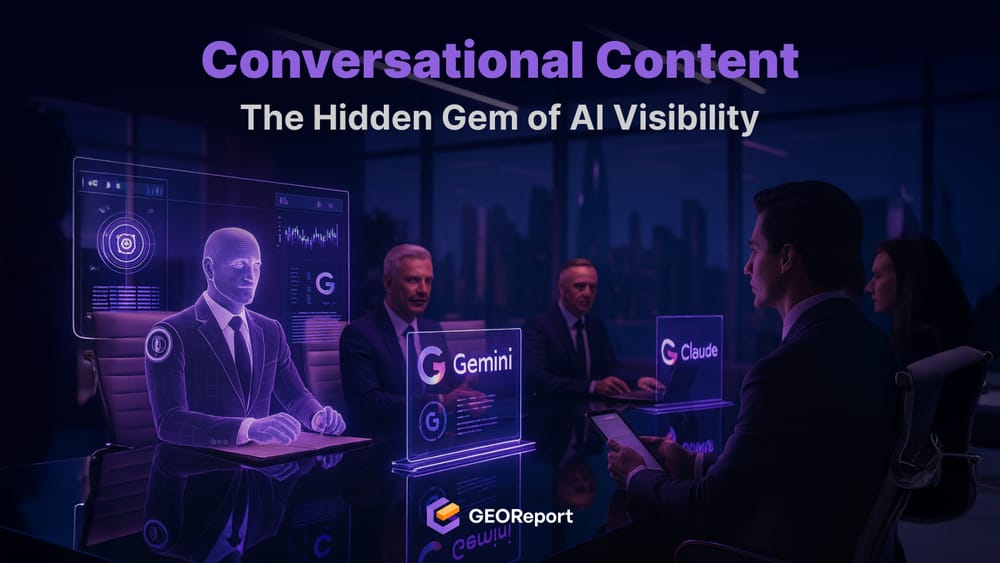BLUF:
Generative engines don’t rank based on keywords; they rank based on understanding. If your content doesn’t sound like a conversation, AI won’t quote it. Conversational content is becoming the new ranking factor in the era of AI search.
From Keywords to Conversations?
For twenty years, SEO rewarded optimization. Writers were told to insert target keywords, control density, and repeat key phrases. That era taught us how to write for crawlers, not for comprehension.
But generative AI changed the reading model entirely. Systems like ChatGPT, Gemini, or Perplexity don’t crawl — they interpret. They don’t count keywords; they analyze dialogue patterns, reasoning flow, and contextual relevance.
The problem? Most brands still write like they’re talking to Google.
AI doesn’t respond to robotic sentences or promotional claims; it responds to conversation patterns. It rewards content that sounds like a human answering another human.
That’s where conversational content becomes a hidden GEO superpower.
Why AI Prefers Natural Dialogue?
LLMs are trained on billions of conversation turns, Reddit threads, Quora questions, Stack Exchange answers, support transcripts, and human dialogue.
Their core logic is built on patterns of question → reasoning → conclusion.

When AI reads your blog, it’s not judging how optimized your subheadings are. It’s asking, “Does this text resemble the format of human knowledge exchange?”
That’s why content written in natural flow, asking questions, explaining reasoning, giving context, is easier for AI to understand, summarize, and cite. Conversational tone doesn’t mean casual tone. It means interpretable logic.
In short:
- SEO content explains what something is.
- GEO content explains why it matters and how it connects.
The moment your writing shifts from keyword placement to conversational reasoning, you move from being indexed to being interpreted.
What Conversational Content Looks Like in Practice
Imagine two brands writing about the same topic: “How to choose a sustainable sneaker.”
Brand A (SEO-optimized):
“Choosing a sustainable sneaker requires eco-friendly materials. The best sustainable sneakers are made from organic cotton or recycled rubber.”
Brand B (Conversational content):
“You might be wondering how to pick a sneaker that’s truly sustainable. The key is to look beyond labels, focus on materials, supply chain transparency, and durability. For example, recycled rubber soles often last longer and reduce waste.”
Both are correct, but only one resembles the kind of reasoning an AI model was trained to replicate. Brand B provides conversational context, intent alignment, and explanatory cues. That structure makes it easier for LLMs to parse, summarize, and reuse in generated answers.
Conversational writing is not about storytelling flair; it’s about predictable interpretability.
How Conversational Flow Improves GEO Scores
At GEOReport, we analyze thousands of AI-generated answers weekly.
Patterns are clear: the most cited content shares three conversational traits, question framing, reasoning continuity, and interpretive density.
- Question Framing:
Articles that naturally pose questions (“How does this work?”, “Why does this matter?”) mirror the structure of user prompts, helping LLMs match query intent. - Reasoning Continuity:
Sentences that explain cause and effect (“because”, “therefore”, “in contrast”) reinforce logical clarity, increasing the chance of being summarized accurately. - Interpretive Density:
Instead of dumping data, conversational writers guide understanding. This helps models extract meaning without distortion.
When your content flows like reasoning, not listing, you align with the model’s inference mechanism. In GEO, interpretability is authority.
The Science Behind It: How LLMs Process Text?
AI doesn’t read words in isolation, it reads relationships.
Each sentence becomes a vector in a multidimensional space representing meaning. When sentences connect naturally through reasoning, AI can trace semantic continuity more easily.
Disjointed or over-optimized text breaks that pattern. That’s why keyword-heavy or repetitive marketing copy is often ignored by AI: it lacks semantic movement.
Conversational writing, by contrast, produces smoother embedding transitions, the same way human thought flows naturally from one idea to another. This helps AI systems cluster your content as coherent, authoritative, and contextually reusable.
In GEOReport audits, pages written in conversational reasoning scored 28–35% higher in AI Citation Probability (AICP) compared to static, keyword-driven pages.
That’s not style, it’s structure.
Why Most Brands Fail at This?
Most content teams are still trained on SEO-era heuristics: “short sentences, target keyword, optimize H2s.” That approach creates clarity for Google, not for generative models.
The gap shows up clearly in AI visibility reports. When asked questions like “What are the best crypto tax tools?” or “How can brands measure AI visibility?”, ChatGPT often cites niche blogs or industry reports rather than large marketing sites. Why? Because smaller players explain, while big brands advertise.
AI ignores slogans. It prioritizes reasoning chains. The brands that sound like teachers, not sellers, dominate GEO results.
How to Write Conversationally for GEO?
Conversational writing isn’t about tone, it’s about structure and flow. It requires reshaping your content from declarative statements into natural reasoning paths.

Practical steps:
- Mirror the query: Start with a natural question similar to how users or AI prompts would phrase it.
- Explain before promoting: Build context first, then connect it to your product or idea.
- Use bridging phrases: “In other words,” “What this means is,” and “Let’s break this down” signal clarity to AI parsing.
- End with synthesis: Wrap sections with conclusions that answer the implicit “why.”
You’re not just writing for users, you’re writing for reasoning engines.
Case Study: The Blog That Tripled Its AI Mentions
In one GEOReport audit, a mid-sized B2B SaaS company rewrote 25 blog articles from SEO-style to conversational-style content. Within 60 days, its brand citations across ChatGPT and Perplexity increased by 3.1x.
Their previous articles were keyword-optimized but rigid. The new versions framed sections as questions, used real reasoning, and ended with concise summaries. Even though the content length and metadata stayed identical, the visibility jump came purely from conversational flow.
AI didn’t just read the content, it started using it.
Why Conversational Content Is the Future of GEO?
Generative engines don’t just mirror human language; they reward it. Every shift from declarative to explanatory structure increases the chance that your content will be remembered, reused, and cited.
In the SEO era, we wrote to be found. In the GEO era, we write to be understood. Conversational content is the bridge between those two worlds.
If your brand can reason clearly, AI will recommend confidently. That’s not optimization, that’s communication.
FAQs
Is conversational writing less formal?
Not necessarily. You can maintain authority while sounding natural. The goal is readability for AI models, not informality for humans.
Can long-form articles still be conversational?
Yes, if they’re structured like guided explanations, not monologues. Each section should answer an implicit or explicit question.
How can I measure conversational success?
Tools like GEOReport.ai analyze citation likelihood, entity consistency, and conversational intent patterns across your pages.
Does conversational tone reduce SEO ranking?
No. In fact, clear reasoning and structured flow can improve engagement metrics, which indirectly support both SEO and GEO performance.
Author’s Viewpoint
The future of visibility isn’t about how much you publish, but how well you reason.
Brands that learn to write in the same conversational logic that AI models think in will define the next decade of digital communication.
When you stop writing at your audience and start writing with them, AI begins to listen, and more importantly, to remember.


